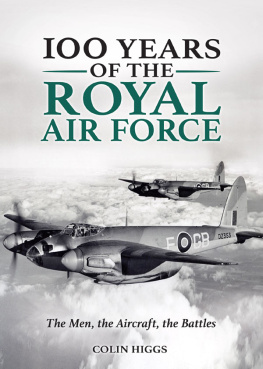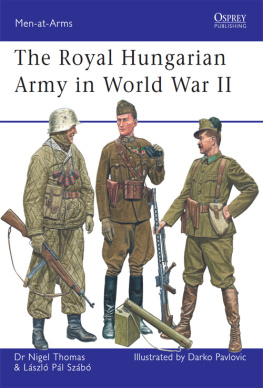
BROKEN WINGS
BROKEN WINGS
The Hungarian Air Force, 1918-1945
Stephen Renner
INDIANA UNIVERSITY PRESS Bloomington & Indianapolis
This book is a publication of
INDIANA UNIVERSITY PRESS
Office of Scholarly Publishing
Herman B Wells Library 350
1320 East 10th Street
Bloomington, Indiana 47405 USA
iupress.indiana.edu
2016 by Stephen Renner
The views expressed in this book are those of the author and do not reflect the views of the Department of Defense or any of its components.
All rights reserved
No part of this book may be reproduced or utilized in any form or by any means, electronic or mechanical, including photocopying and recording, or by any information storage and retrieval system, without permission in writing from the publisher. The Association of American University Presses Resolution on Permissions constitutes the only exception to this prohibition.
The paper used in this publication meets the minimum requirements of the American National Standard for Information SciencesPermanence of Paper for Printed Library Materials, ANSI Z39.48-1992.
Manufactured in the United States of America
Cataloging information is available from the Library of Congress.
ISBN 978-0-253-02294-3 (cloth)
ISBN 978-0-253-02339-1 (ebook)
12345212019181716
I will convince them of the tremendous importance of aviation to our countrys reconstruction, and that without its development, a broken-winged Hungary will fall behind the other peoples of the world.
COLONEL ISTVN PETRCZY, 1921
Contents
Acknowledgments
I must thank Professors Robert J. W. Evans and Sir Hew Strachan for their guidance, perceptive insights, and encouragement.
For his assistance on matters of style and grace, and for excising as many infelicities as possible, I shall always be grateful to my late friend Mr. Rodney Allan.
I could not have completed this book without the assistance of the archivists in Budapest: at the Defense Ministry Archives and Library, Mr. Balzs Kiss and Ms. Judit Hegeds; at the National Archives, Ms. Ildik Szernyi and Mr. dm Trk; at the Transportation Museum and Archives, Mr. Sndor Krizsn. I am especially indebted to Professor Mikls M. Szab (Lt. Gen., ret.), author of the best works on the Hungarian Air Force. Professor Szab is a tireless correspondent and made time to meet me in Budapest. That meeting was facilitated by Jnos Isaszegi, PhD (Maj. Gen., ret.), who also helped me with publications from Zrinyi Press. Colonel Greg Clawson and his wife Laura provided amazing hospitality during my trips to Hungary. Professor Eric Weaver of Debrecen University pointed me to critical sources and provided invaluable editorial assistance throughout the project. I thank my extraordinary friends, Szabolcs Takcs and Andrea Szentendrei, whose calls and emails on my behalf are the least of their contributions.
The photographs are courtesy of Mr. Pter Zmbori (by way of Dr. Szab), Mr. Dnes Bernd, various contributors to the Fortepan.hu online collection, and the Norsk Luftfahrtmuseum.
The faculty of the US Air Force School of Advanced Air and Space Studies have such enthusiasm for their work that I was inspired to join them. Professors Tom Hughes, Rich Muller, and Hal Winton have been particularly helpful with the thinking and writing; Professors Steve Chiabotti and Steve Wright and Ms. Sheila McKitt have been wonders of administrative support.
My parents, Gene and Ginny Renner, raised me with a love of reading, which has led indirectly to this project.
Finally, I thank my lovely wife, Jenny. For everything.
Note on Sources and Translation
Archival material for this book came primarily from the Hungarian Defense Ministry archives in Budapest. Most of the air forces own documents were destroyed in the Second World War, but sizable elements of the Defense Ministry and General Staff archives relate to aviation matters. The Defense Ministry archives also contain a number of unpublished manuscripts and memoirs. Jnos Vesztnyis manuscript was extremely helpful, as was Lszl Winklers unpaginated scrapbook of documents, photographs, and press reports. In the Defense Ministry archives library can be found Magyar Katonai Szemle, the professional journal of the Honvdsg, and the primary source for the discussion of air power theory in . The Hungarian National Archives hold Admiral Horthys papers, among which were his handwritten notes from the 1938 presentation on air force independence. The Hungarian Transportation Museum and Archives has valuable information on the Hungarian airlines and sport aviation. Other primary sources include various document collections of the Hungarian, German, and British Foreign Ministries, along with the printed confidential documents of Mikls Horthy. The destruction of the Royal Hungarian Air Force archives means that important operational details have been lost; in particular, those relating to logistics and intelligence, which would not have been addressed in General Staff or Defense Ministry records, and which might have seemed less important to memoirists or oral historians.
The most important secondary works on the Royal Hungarian Air Force have been authored by Dr. Mikls M. Szab. His Magyar Kirlyi Honvd Lgier 19381945 is the best work on the subject, includes the major elements of his earlier work, and has extensive documentation. Fejezetek a magyar katonai repls trtnetbl, coauthored by Szab with S. Nagyvradi and L. Winkler, is the most useful guide to the early years of Hungarian military aviation; its reference notes are less complete than Magyar Kirlyi Honvd Lgier 19381945, but it includes something rarely found in other Magyar books on the topican index. The journal Hadtrtnelmi Kzlemnyek carries the most relevant recent articles on military history. There are few English-language works on the Hungarian Air Force, and with the exception of the newly published Baptism of Fire by Csaba Stenge, those rely on personal reminiscences or German works. For the Habsburg aviation experience, the best work is the unwieldy but tremendously informative Austro-Hungarian Army Aircraft of World War, by Peter Grosz, George Haddow, and Peter Schiemer.
Memoirs play an important role in determining personal experiences and filling in crucial details, but due to the hyperpoliticization of Hungarian life in the twentieth century, they must be used with caution. Issues of motivation, both ones own and attribution to others, seem especially susceptible to post hoc revision. Works published in Hungary during the Communist period have the obligatory references to the imperialists and counterrevolutionaries, but deeper biases exist as well. The Kassa bombing scarcely figures in pre-1990 journals in Hungary. Magyar-language works published by emigrants to the West have the same tendency toward self-justification, exacerbated by Cold War tensions.
For understanding Hungarys political situation in the period, C.A. Macartneys October Fifteenth and Gyula Juhszs Hungarian Foreign Policy 19191945 were indispensable.
Unless otherwise noted, all translations from Hungarian are my own.
List of Abbreviations
AAA | antiaircraft artillery |
AICC | Aeronautical Inter-Allied Commission of Control |
BCR | Bombardement-Combat-Reconnaissance |
CAM | Corpo Aeronautica Militare ([Italian] Military Air Corps) |
DR.GY | Dunai Replgpgyr RT (Danubian Aircraft Factory) |
Next page












